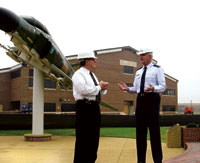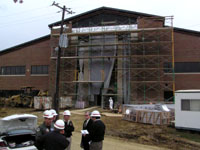The U.S. Air Force's Air Combat Command, the service's largest major command with more than $1.2 billion in construction and waste cleanup work it performs or manages, used to see 90% of its projects come in late. Now, using a motivational approach familiar to football fans, the command has turned its performance record around. Now 75% of ACC's projects over the last three years have come in ahead of schedule and 90% of ACC's current projects are ahead of an aggressively accelerated schedule. At the same time, project costs have dropped from 3.8% over budget four years ago to 0.3% over budget in the fiscal year that ended last September.
Air Force officials were less than thrilled with the performance of the eight major commands in general, chastising them for failing to keep their own construction forces and the other military services that build for them in step with private sector peers. Hotel-sized military base dormitories, for example, were taking 22 to 28 months to build. That was not acceptable. "If it takes a year [plus] to build a Holiday Inn Express, then I want similar timelines and speed," says Maj. Gen. Dean Fox, the Air Force Civil Engineer, Washington, D.C.
William Sorrentino, chief of the technical services division of the Corps' Norfolk District says, "The Air Force has a metric of 0% time growth and 0% cost growth. While that isn't reasonable, they set that goal and that's what they want. The Army set a goal of 5% on time and 2% on cost growth; the Air Force came in with zero and zero."
ACC, at Langley Air Force Base near Newport News, Va., manages design, construction and maintenance of U.S. fighter and bomber bases domestically and in several Middle East countries. That includes dormitories, housing, operations centers, day care centers, kitchens, hangars, training centers, specialized maintenance facilities and office buildings. By federal mandate, the Army corps of engineers builds about 85% of the command's building projects, the Naval Facilities Engineering Command (NAVFAC) handles 10% and ACC itself about 5%.
 |
| Teaming Up. Firman, left, and Burns formalized focus on "Red Zone" to close out projects sooner and with shorter punchlists. (Photo by Capt. Brian Hartless) |
Brig. Gen. Patrick A. Burns, civil engineer for ACC, and Dennis Firman, its chief of construction, took on the zero-zero challenge. In 2001, the Burns-Firman team set in motion a multi-pronged approach that expedites remediation of once off-limits environmentally distressed sites, integrates base redevelopment with neighboring municipalities and, most importantly, adapts football's so-called "Red Zone" approach that zeroes in on moving the ball the last 20 yards to the goal. In ACC's case, the focus was on the last 90 days of a project.
Burns and Firman determined that projects tended to get bogged down near the end. "We knew we needed a solution," says Burns. "We didn't know what to look for right off hand, but Dennis Firman, God bless him, got the solution as he was watching the Washington Redskins lose a football game in the last minutes" by not getting from the red zone to the goal line.
 |
| The $22-million ACC Operations Support Center at Langley AFB in Virginia is scheduled for completion this summer. It is the largest and most complex single building to benefit from integrated planning initiatives, and is ahead of schedule and under budget, says Burns. (Photo by Judy Schriener) |
ACC partnered with the Corps to come up with their own Red Zone. It's a formalized, structured plan that aims to move projects to completion faster and more efficiently, starting with a close-out meeting of all stakeholders at 60 to 90 days prior to finish. The Red Zone focuses on "a lot of the documents that get pushed aside until someone starts pushing and crying about them," says Jon Jones, project manager for Langley work for the Corps' Norfolk District.
The Air Force saved $12 million on several projects over the past few years at Langley, partly due to the Red Zone, says Brig. Gen. Bo Temple, commander of the Corps' North Atlantic Division, Brooklyn, N.Y. "We are able to successfully deconflict all of these tasks that have great potential to derail the project," he says. "There's no question we've been able to do a better job for ACC and the Air Force in general than we were before the Red Zone was established."
|
For example, the $7.8-million Communications Squadron facility at Beale AFB, California, finished with 0% cost growth in 505 days, 35 days earlier than targeted. The $5.7-million Shaw AFB dining facility in South Carolina also did well. "We instituted our new 540-day construction duration limit based on studies of similar sized facilities in the private sector, and the contractor finished it in 508 days with only a 1.66% cost growth due to added user-requested features," says Burns. And, the $12-million fitness center at Langley was completed at 0% cost growth in 625 days, 27% earlier than the 810 days the Corps recommended and 13% earlier than the more aggressive target date of 720 days set by ACC. All successes were partly due to the Red Zone strategy, says Burns.  Click here to view chart
Click here to view chart
"The increase in time to deliver projects from the baseline has been decreasing over the past few years from 15% down to about 5% and starting to approach zero now," says John Popelka, chief of military works for the Corps' Northwestern Division, Omaha, Nebr. "It really is working for us and our customers," adds Col. Yvonne Prettyman-Beck, commander and district engineer of the Corps' Norfolk District.
Initially only ACC used the Red Zone. As the other commands and the Air Force as a whole considered the program in the spring of 2002, the Corps of Engineers actually adopted it first on all of the Air Force's projects. "When the Corps adopted it, it made it easier for the rest of the Air Force to adopt it," says Paul Parker, director of the AF Center for Environmental Excellence, San Antonio, Texas. Parker was an executive at ACC for seven years. That the Corps adopted the Red Zone before the Air Force is a source of amusement at ACC, but Fox calls it "an irrelevant piece of data." Fox was impressed with the Red Zone initiative. "I dug into what they were doing and...

Post a comment to this article
Report Abusive Comment